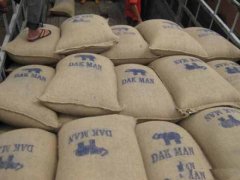Analysis of acid components in boutique coffee knowledge coffee
Coffee acidity is often thought to be related to coffee quality. Acidity is characteristic of high value coffees typical of Central America and East Africa. Excessive sourness is considered a disadvantage of coffee. Acidity is associated with cultivation at very high altitudes and mineral-rich volcanic soils.

The acidity of water-washed beans is higher than that of sun-dried (naturally dried) beans. Sun-dried beans are heavier than water-washed beans because the concentration masks the acidity of coffee. The acidity of coffee drinks has a lot to do with the degree of roasting, as well as the roasting method and brewing method. Coffee pH is also related to coffee acidity. A good cup of coffee has a pH between 4.9 and 5.2.
Green and roasted coffee beans contain more than 100 acids. Chlorogenic acid and quinic acid are the main acids in raw beans, followed by malic acid and citric acid. The chlorogenic acid complex in baking is broken down into smaller components, forming components such as acetic acid and formic acid. Due to their high volatility, these components disappear during the subsequent baking phase.
chlorogenic acid
Chlorogenic acid is actually an ester component between quinic acid and phenols like cinnamic acid. Coffee is most abundant in 5-O-caffeoylquinic acid, an ester intermediate between quinic acid and caffeic acid. More than 17 different chlorogenic acids have been found in Robusta green beans, but the amount of chlorogenic acid seems to vary depending on the origin, type and coffee.
caffeic acid
Coffee provides the richest dietary source of chlorogenic acid. According to reports, a 200cc cup of coffee contains 70-350 mg chlorogenic acid, which will supply 35-175 mg caffeic acid. Chlorogenic acid in coffee has health benefits. Although chlorogenic acid and caffeic acid have antioxidant effects in vitro, how much is unknown because they are extensively metabolized in the body and their metabolites often have lower antioxidant power than their precursors.
Caffeic acid is present not only in coffee, but also in a large number of edible and inedible plants. With antioxidants. On the other hand, current studies suggest that caffeic acid may also be carcinogenic. The health benefits of caffeic acid are unknown.
Important Notice :
前街咖啡 FrontStreet Coffee has moved to new addredd:
FrontStreet Coffee Address: 315,Donghua East Road,GuangZhou
Tel:020 38364473
- Prev

Coffee cup test knowledge the aroma of coffee has exceeded 800 kinds.
The aroma of coffee itself is the main reason for the overall flavor properties, which is different from the perceived taste and sweetness, saltiness, bitterness and sour taste. Aroma is the most important product attribute of special coffee, and even instant coffee aroma substances can stimulate our taste buds. The difference is that instant coffee lacks the most important aromatic volatile components, which also leads to a decrease in the overall flavor.
- Next

Basic knowledge of boutique coffee the mellow and bitter taste of coffee
The color, aroma and taste of coffee are caused by some complex chemical changes that take place during the baking process. Generally speaking, we use strong alcohol to show the round, mellow and strong taste of coffee. So raw coffee beans must go through a proper chemical process to achieve the most balanced state of its essential ingredients in order to be regarded as the best baked beans. The aroma of coffee will follow the heat.
Related
- Beginners will see the "Coffee pull flower" guide!
- What is the difference between ice blog purified milk and ordinary milk coffee?
- Why is the Philippines the largest producer of crops in Liberia?
- For coffee extraction, should the fine powder be retained?
- How does extracted espresso fill pressed powder? How much strength does it take to press the powder?
- How to make jasmine cold extract coffee? Is the jasmine + latte good?
- Will this little toy really make the coffee taste better? How does Lily Drip affect coffee extraction?
- Will the action of slapping the filter cup also affect coffee extraction?
- What's the difference between powder-to-water ratio and powder-to-liquid ratio?
- What is the Ethiopian local species? What does it have to do with Heirloom native species?

